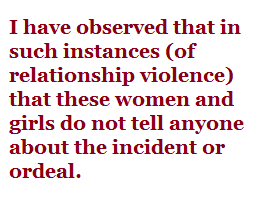
The Feminisation of HIV refers to the increasing prevalence of HIV among women worldwide and the ways in which gender discrimination – both social and institutional- contribute to women’s increased vulnerability to HIV infection. In the Caribbean, women make up 53% of the population living with HIV. And young women between the ages of 15-24 have three to six times higher incidence of HIV than young men the same age range. High rates of violence against women; poverty and economic dependence on men; and cultural attitudes regarding relationships and sexual behaviour; all contribute to the increasing incidence of HIV among Caribbean women.

How long have you been working in HIV in the Caribbean or Trinidad?
More women are testing. Some are initiating condom use at the start of the relationship. Many women are not reliant on men so this gives them the freedom to end the relationship if the man is unfaithful or if they believe that he is putting them at risk. I met a young woman last week, who ended the relationship because at the end of the sexual act she discovered that he had removed the condom during the act without her knowledge. Still, there are some women who would test ever year but go back to the same situation.
 What “same situation”?
What “same situation”?
They are in a relationship where they know that the man is unfaithful, he does not or will not use condoms. He also does not believe that he needs to be tested or that his infidelity puts him at risk for HIV. The client will knowingly go back to this situation. A lot of the time the woman is ‘biding time’ either for the children to grow up, for her to get a job or for him to move on. There are also some who are in the marriage ’till death do us part’ and test every six months. They say “He is my husband what can I do?” They hope and pray for a negative result and also for divine intervention.
In your counselling of HIV infected women, what are some of the most common stories you hear about how women become infected?
The most common story with HIV infection is that they trusted the other partner. Even though they started using condoms (at the beginning of the relationship), they stopped once they thought that they were comfortable with each other. So I tell clients that trust in HIV starts after both persons have tested maybe twice (baseline and confirmatory) depending on their situation, and stay faithful after. Another story is that the man does not like how the condom feels, and he looked ‘clean’.
What does ‘baseline and confirmatory’ mean?
The “baseline” test may be the 1st time the client is testing, or the first test after their unprotected sexual encounter. If this test is done today, it will tell us the client’s HIV status 3 months ago. Any unprotected sex they had in the last three months would not show up in this test, therefore the client would need to be tested again (confirmatory test) 3 months after the last time that they had unprotected sex.
 How does relationship violence – (coerced sex, battering, rape. financial abuse) – contribute to women contracting HIV?
How does relationship violence – (coerced sex, battering, rape. financial abuse) – contribute to women contracting HIV?
I have observed that in such instances (of relationship violence) that these women and girls do not tell anyone about the incident or ordeal. It is only in trying to understand their ‘story’ that I find out. These clients I usually refer to Rape Crisis and/or for further counseling. Those who have been physically abused, by the time they decide to get tested, they have already addressed their spouse’s “behaviour” and are in better place mentally, if not physically, and I would refer them for further counselling or to the Domestic Violence Hotline.
What do you mean by “in a better place” – have they left the relationship?
Some may have made compromises and decisions that are tolerable, livable. Others have accepted their situation, found solace in the church, found some way not to have sex, or found somewhere where they can escape in their minds, and some have left the relationship.
What do you feel needs to be done to lower the rate of HIV infection in women and girls in the Caribbean?
I feel that proper counselling needs to be done across the board (for men and women). Counselling that includes exploring with the client how they can reduce their risk. These days our HIV Testing is focused on getting as many persons tested as possible. I feel that more education needs to be done as the general population doe not understand the basics of HIV.
A part of what the counsellor should also do is explore ways that women and girls can ‘better’ themselves. We usually have information on the level of education and job details from the clients so we can encourage and give referrals to some of the programmes available for continuing education, skill training or further counselling they may need.

